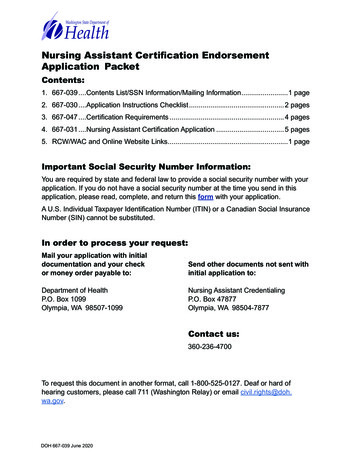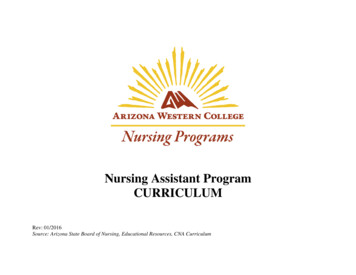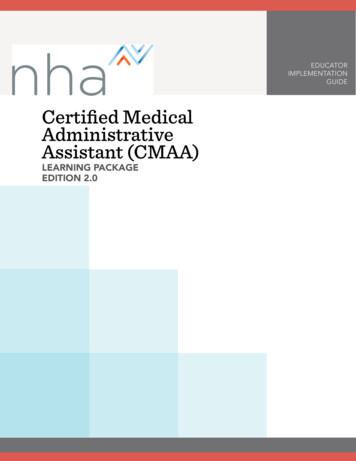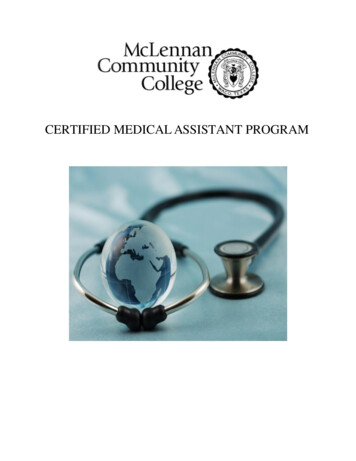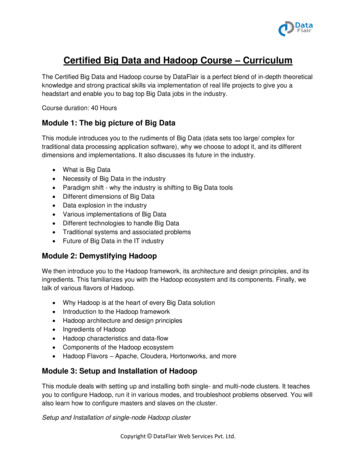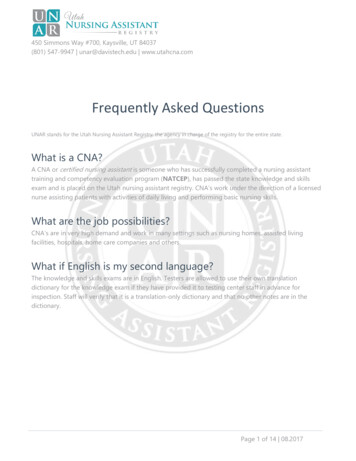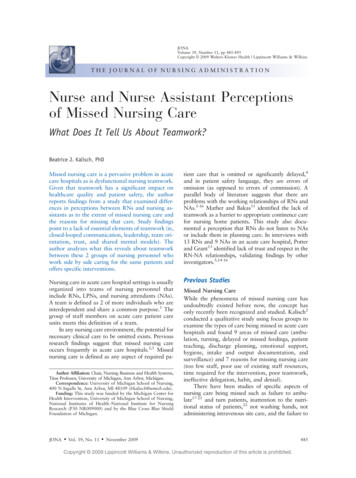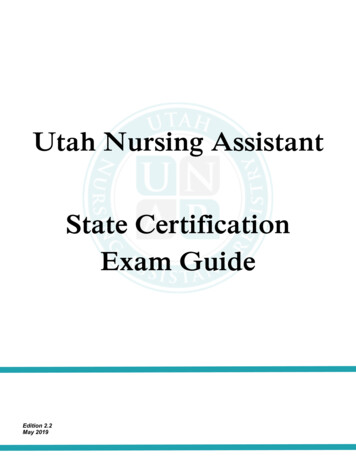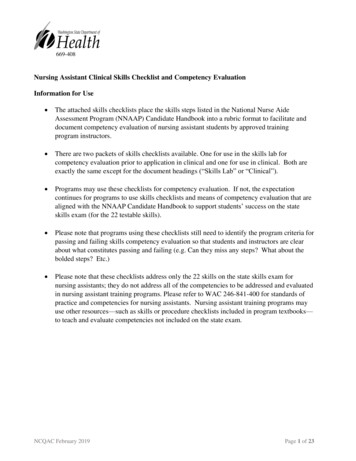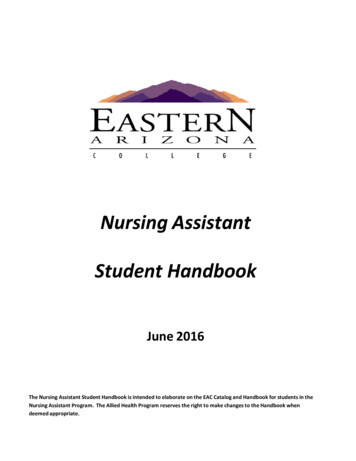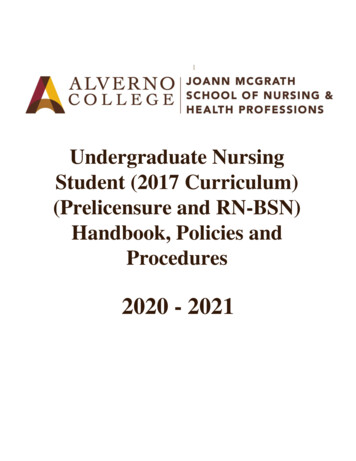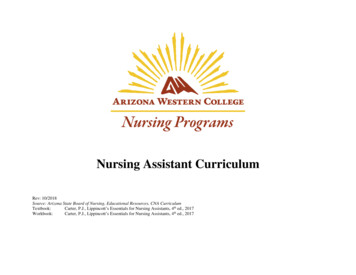
Transcription
Nursing Assistant CurriculumRev: 10/2018Source: Arizona State Board of Nursing, Educational Resources, CNA CurriculumTextbook:Carter, P.J., Lippincott’s Essentials for Nursing Assistants, 4th ed., 2017Workbook:Carter, P.J., Lippincott’s Essentials for Nursing Assistants, 4th ed., 2017
The nursing assistant training program curriculum was developed by the Nursing Assistant Advisory Committee and approved by the Arizona State Board ofNursing on January 27, 2006. The curriculum incorporates Article 8 Nursing Assistants rules implemented on December 5, 2005, and meets the requirements ofR4-19-802 (B) (1) through (B) (4) and R4-19-802 (C) (1) through (C) (14). Approved training programs may use this curriculum as a template to develop/writeindividual program curriculums.1.0 Competency: Functions as a member of the health team within the health care facility and/or community. Time Allotted: 6 hrs.Learning GoalsContent OutlineLearning Activities and/or Reading AssignmentResources1.1 Identifies essential functions of the healthFunctions, similarities, difference in theRead:care facility and states the differencesfollowing:between acute, long-term, assisted living, Chapter 1: The Health Care Systemhome care and hospice. Chapter 2: The Nursing Assistant’s Job Chapter 3: Professionalism & Job-Seeking Skills Chapter 10: Overview of Long-Term Care Arizona State Board of Nursing, Nurse Practice Act A. Acute careRules: Article 8. Certified Nursing AssistantsB. Long-term careC. Assisted LivingAssignment: Complete related Workbook chapters.D. Home careE. RehabilitationF. Hospice.1.2Explains the essential duties of the nursingteam within a care facility.Functions and duties of nursingpersonnel:A. Identifies the essential function of the RN.A. RNB. Identifies the essential function of the LPN.C. Identifies the essential function of the nurseassistant.B. LPN2
D. Discuss the elements of a functioning team.E. Works with other members of the team e.g.,physician, dietician, Dietary Technician,Physical Therapist, Nurse Practitioner,speech therapist and Social WorkerC. Nurse AssistantD. Organization structureE. Working with other members of theteam e.g., physician, dietician, DietaryTechnician, Physical Therapist, NursePractitioner, speech therapist and SocialWorker1.31.4Explains the nursing assistant role asoutlined in the different regulatory andprofessional guidelines.Describes the delegation process.Regulatory agencies and professionalguidelines.A.Omnibus Budget Reconciliation Act(OBRA)B.Arizona State Board of Nursingprescribed requirements forcertificationC.Arizona State Board of Nursingprescribed requirements forrecertificationD.Standards of conduct (R4-19-814)E.Ethics in the workplaceF.Informed consentG.Advanced Directives/ do notresuscitateDelegation process:3
1.5Demonstrates professional work habits andtime management skills.A.Responsibility and accountability indelegationB.Factors affecting delegationC.5 Rights of delegationD.Accepting and refusing delegationGuiding principles:A.Time management skillsB.Application in the work settingC. Realistic resident care assignmentload1.6Demonstrates appropriate stress relievingtechniques.Guiding principles:A.Stress management techniquesB.Application in the work setting2.0 Competency: Demonstrates ethical and legal behavior that maintains resident’s rights. Time Allotted: 2 hrs.Learning GoalsContent OutlineLearning Activities and/or Reading AssignmentResources2.1 Demonstrates ethical and legal behavior byRegulatory agencies and professionalRead:maintaining the standards set forth for theguidelineshealth care professions. Chapter 2: The Nursing Assistant’s Job Chapter 6: The Patient’s or Resident’s EnvironmentA. Explains the functions, roles responsibilities(Objective 2.7)and legal limits of nursing Chapter 19: Bedmakingassistant/practice.4
B.C.Discuss the regulatory boards, state andfederal statutes, rules and regulations,standards and legal and advisory opinionsthat affect the practice of the nursingassistant.Explains state certification and renewalrequirements for NAs – include criminalconduct.A. Concepts of ethical and legalbehavior for healthcare professional(emphasis on nursing assistantstandards)B.C.Functions, roles, limits and statecertification process under theArizona State Board of NursingStandards of Conduct for NursingAssistants; Federal laws regulatingstandards of care/conduct (OmnibusBudget Reconciliation Act –OBRA); Joint Commission onAccreditation of HealthcareOrganizations (JCAHO) standardsand Occupational Safety and HealthAdministration standards (OSHA) Chapter 15: Patient & Resident Safety (Objective2.10)Chapter 1: The Health Care System (Objective 2.11)Chapter10: Overview of Long-Term CareChapter 7: Basic Body Structure & Function(Objective 2.12)Assignment:Complete related Workbook chapters.Nursing Assistant Certification1. AZBN Basic EducationalRequirements2. Process for initial certification3. Felony Bar – criminal conduct4. Certification renewalrequirementsD.Identifies the standards of conduct that thenurse assistant must maintain in their dailycare of residents.D. Standards of conduct1. Federal2. Arizona Standards of Conduct forNursing Assistants3. JCAHO standards4. OSHA standardsE.Demonstrates professional behaviors.E. Characteristics of professionalbehavior (examples such as):1. Caring2. Competent3. Conscientious (including personalhygiene)4. Courteous5
5.6.7.F.Accurately utilizes vocabulary words/termsrelated to ethical/legal behavior and residentrights.Dependable/TimelyHonestTeam playerF. Key Terms1. Abandonment2. Abusea. Physical abuseb. Sexual abusec. Verbal abused. Emotional abuse Threats Humiliatione. Involuntary seclusionf. Financial abuse3. Advance Directive4. Advocate5. Assault6. Battery7. Code of conduct8. Defamation of charactera. Slanderb. Libel9. Dual relationship &professional boundaries10. Ethics11. False imprisonment12. Informed consent13. Invasion of privacy14. Neglecta. physical neglectb. psychosocial neglect15. Ombudsman16. Privacya. Personalb. Visitsc. Telephone conversationsd. Information about care17. Quality of Life18. Restraints6
a. Chemical restraintsb. Physical restraints19. Self-Determination Act20. Standards of Care21. Theft2.2 Interprets, explains and applies the Resident’sBill of Rights.Principles and rationale of Resident’sRights (Right to )A.Free choiceB.Freedom from abuse and restraintsC.PrivacyD.Confidentiality of personal andclinical records (Health InsurancePortability and Accountability Act HIPAA standards)E.Accommodation of needs1. Physical2. PsychosocialF.Organize and participate in family &resident groupsG. Participate in social, religious andcommunity activitiesH. Examine survey results andcorrection plansI.Manage personal fundsJ.Information about eligibility forMedicare/Medicaid benefitsK.File complaints about abuse, neglector misappropriation of property7
L.Information about advocacy groupsM. Immediate & unlimited access tofamily or relativesN.Share a room with partner/intimacyO.Perform or not perform work for thefacilityP.Remain in the facilityQ.Use personal possessionsR.Notification of change in condition2.3 Provides for resident privacy.Principles and rationale of right toprivacy:A.Describes the resident’s right to privacy.A.Review methods to maintain privacy(i.e. not taking VS in public areassuch as the dining room).B.Explains how the nursing assistant can helpthe resident maintain the right to privacy.B.Maintaining privacy whileperforming resident care.2.4A.B.2.5Maintains resident confidentiality.Principles and rationale of maintainingconfidentiality:Describes the resident’s right toconfidentiality.A.HIPAA regulations onconfidentiality “unintendedreceiver”.Identifies how the nursing assistant canprotect the resident’s right toconfidentiality.B.Methods to protect the resident’sright to confidentiality.Promotes the resident’s right to makepersonal choices to accommodate theirneeds.Principles and rationale of promotingresident’s personal choices:8
A.Describes the resident’s right to personalchoice.A. Guidelines, examples situationsdescribing the right to choose.B.B. Offers choices when caring for residents.2.6 Gives assistance in resolving grievances anddisputes.A.Describes the resident’s right to voicedisputes and grievances.B.Explains the role of the nursing assistantwhen residents voice concerns, complaintsor questions about treatment or care.2.7Maintains care and security of resident’spersonal possessions.A.Describes the resident’s right related to thecare and security of personal possessions.B.Explains the role of the nursing assistant insafeguarding resident’s personalpossessions.Methods to protect the resident’srights to make personal choices.Guidelines in resolving grievances.A.Key terms and concepts:1. Grievance2. Ombudsman3. Resident’s CouncilB.Methods to resolve grievances anddisputes within the nursing assistantrole.Security of residents’ personalpossessions.A. Principles and rationale ofsafeguarding residents’ personalpossessions.B. Methods to care and secure residents’possessions.1. Safe for valuables2. Labeling personal items andcontainers.2.8Promotes the resident’s right to be free fromabuse, mistreatment and neglect.Principles and rationale of protectingresident from abuse, mistreatment andneglect:9
A.Explains the role of the nursing assistant inprotecting the resident from abuse,mistreatment and neglect.B.Describes types of elderly abuse.C.Identifies signs of abuse.B. Methods to protect the resident fromabuse, mistreatment and neglect.2.9Reports any instance of abuse, mistreatmentor neglect to the appropriate supervisor.C. Signs of resident abuse.Principles and rationale to report abuse,mistreatment or neglect:A.Discuss the legal requirement andconsequences for failure to report abuse,mistreatment or neglect.B.Reviews appropriate methods and chain ofcommand to report instances of abuse,mistreatment or neglect.2.10 Utilizes interventions that minimize theneed for restraints.A.B.Identifies ethical and legal issues in the useof restraints.Describes the resident’s right to be free ofrestraints.A. Signs of abuse, mistreatment andneglect.A. OBRA and state requirements1. Employee responsibility2. Consequences for failure to report.B. Methods to report abuse,mistreatment or neglect:1. Chain of Command2. Facility policy3. Community agenciesPrinciples and rationale for theappropriate use of restraints.A. Ethical and legal issues of usingrestraints.1. JCAHO guidelines2. Physician orders3. Release restraints every 2 hoursand document4. Methods to avoid using restraintsB.Right to be free from restraint1. Informed consent2. Least restrictive form10
3. Types of restraintsa. Physicalb. Chemicalc. Active restraintd. Passive restraintC.D.Identifies the role of the nursing assistant inhelping to keep the resident free fromrestraint.Provides for resident’s basic needs and reapplies restraints as appropriate.C. Alternative to restraints.1. Diversion2. Company3. Activities4. Exercise5. Basic needs met6. OtherD. Care of resident in restraint1. observe according to protocols2. restraint removed, personrepositioned, basic needs met atleast every 2 hoursE.Observes and reports resident’s status whilein protective devices.E. Agency guidelines for checkingresident and documentation2.11 Promotes resident independence.A.B.Describes the resident’s right related to selfdetermination, self care and independence.A. Principles and rationale of promotingresident independence.Identifies actions nursing assistants maytake to promote resident independence.2.12 Assists residents to participate in activities.A.Guidelines to support resident’sindependence.Describes the resident’s right to participatein family and group activities.B. Methods to promote resident’sindependence.Guidelines to support resident’sinvolvement in activities.A. Principles and rationale of assistingresident to participate in activities.11
B.Provides for activities of daily living andrestorative activities for clients.1. Activities of Daily Living2. Family meetingsB. Methods to assist resident toparticipate in activities.3.0 Competency: Assists in identifying the mental health and social service needs of residents. Time Allotted: 4 hrs.Learning GoalsContent OutlineLearning Activities and/or Reading AssignmentResourcesBasic Human NeedsRead:3.1 Discuss basic human needs of the individual.A. Identifies basic human needs throughout thelifespan, including physical, socio-cultural,social service and mental health needs.B.A. Maslow’s hierarchy and Erickson’sdevelopment stages Identifies the developmental tasks associatedwith the aging process.B. Basic human needs of the adultmoving from middle adulthoodthrough late adulthood.Chapter 5: Those We Care For (Objective 3.1)Chapter 11: The Long-Term Care ResidentChapter 8: Common Disorders (Objective 3.3, 3.4,3.5)Chapter 5: Those We Care For (objective 3.6, 3.7)Assignment:Complete related Workbook chapters.1. The young-old: 60-74 years2. The middle-old: 75-84 years3. The old-old: older than 85 yearsC.Describes mental status and behaviorchanges.D. Identifies the role of the elderly in the homeand community, including cultural andreligious aspects.C. Mental and behavior changes1. Impact of restrictions such asreduced income on psychosocialrelationships.2. Changes due to disease processand agingD. Role of elderly in home andcommunity.1. Cultural and religious outlooksabout older adults.2. Changing family dynamicsthroughout aging.12
3.2 Explains how cultural and spiritual attitudesmay influence psychological responses.A. Identifies ways to accommodate cultural andspiritual differences.3. Housing options as agingprogresses.4. Impact of retirement andincreased time and availability.Examples of cultural and spiritualpreferences and responses that mayinfluence the approach to caring for theresident.A. Health care beliefs.B.Identifies the nursing assistant’s role inrespecting cultural and spiritual differences.B. Sick care practices.C. Family members’ roles.3.3 Identifies sources of stress common toresidents.Basic concepts of Mental Health.A. Defines stress.A. Definition of stress.B.Explains the difference between mental healthand mental illness.B. Definition of mental health.C.Identifies nursing assistant’s responsibility ofreporting signs and symptoms of stressand/or inappropriate coping mechanisms tosupervisor.3.4 Provides appropriate care for residents withmental health problems.C. Common causes of stress related tolife stages.1. Signs and symptoms of stress2. Common coping mechanisms3. Potential for self harmCare for residents with common mentalhealth problems.A. Anxiety13
B. DepressionC. Affective disordersD. SchizophreniaE. Substance abuseF. Eating disordersG. Potential for self-harm3.5 Modifies own behavior in response to residentbehavior.A. Identifies the nursing assistant’s role inmaintaining a respectful attitude for theperson who displays difficult behavior.B.A. Nursing assistant role when interactingwith residents exhibiting difficultbehavior.Identifies at least three effective approachesto managing difficult behavior of residents.B. Effective approaches to managingdifficult behaviors of residents.1. Distraction.2. Relaxation techniques3. Calm environment4. Adjusting time of care5. Encouraging familyparticipation3.6 Describes ways that residents may beexpressing their normal sexuality.Appropriate and inappropriateexpressions of sexuality.A. Identifies common myths related to sexuality.A. Common myths.B.Identifies nursing assistant’s responsibility ofreporting inappropriate expressions ofsexuality to supervisor.B. Reporting responsibilities related tosexuality.14
3.7 Facilitates the resident’s expression of needsand provides supportive communication.A.Various communication methods andenhancing two-way exchange of ideasand responding to needs.Assists and encourages residents to beindependent in the activities of daily living.B.Modifies care to accommodate residentvalues, customs, preferences or habits.C.Utilizes resident’s family as a source ofresident emotional and/or spiritual support.A. Supporting choices and control inactivities of daily living.B. Adaptation of personal care toaccommodate resident preferences.C. Family participation in supporting theresident to strive towards commongoals.4.0 Competency: Demonstrates effective communication. Time Allotted: 2 hrs.Learning GoalsContent Outline4.1 Uses verbal and nonverbal communication toaccurately present information.A. Uses appropriate medical terminology andabbreviations.B.Communicates with members of thehealthcare team.C.Communicates with residents and family.Communication concepts:Learning Activities and/or Reading AssignmentResourcesRead: A. Medical terminology andabbreviations.Chapter 4: Communication SkillsAppendix B: Introduction To The Language OfHealth CareAssignment: Complete related Workbook chapters.B. Types of communicationChain of command.Lab:C. Communication techniquesConflict management Complete a resumeJob interview (Done last week of class)4.2 Responds effectively to resident’s behavior ina positive non-threatening way.Principles of positive communication.A. Identifies communication guidelines.A. Communication guidelines15
B. Identifies barriers to communication.B. Barriers to communication.4.3 Observes and describes resident’s physicaland emotional condition changes.Key concepts for recognizing changes toreport.A. Identifies subjective observations.A. Subjective observations.B. Identifies objective observations.C. Identifies emergencies.B. Objective observations.C. When to report.1. Emergencies versus routineobservations.2. Timeliness of reportingobservations.4.4 Demonstrates communication skills with theresident who has sensory deficits.A. Demonstrates effective communication withhearing impaired resident.Communication skills for residents with asensory deficit.A. Guidelines for communicating withthe hearing impaired.B.Demonstrates effective communication withthe visually impaired resident.C.Demonstrates effective communication withthe aphasic resident.D.Demonstrates effective communication withthe cognitively impaired resident.C. Guidelines for communicating withthe aphasic resident.E.Communicating with the comatose resident.D. Guidelines for communicating withthe cognitively impaired resident.F.Demonstrates effective communication withthe physically aggressive resident.B. Guidelines for communicating withthe visually impaired.E. Guidelines for communicating withthe comatose resident.16
G.Demonstrates effective communication withthe verbally aggressive resident.F. Guidelines for communicating withthe physically aggressive resident.G. Guidelines for communicating withthe verbally aggressive resident.5.0 Competency: Maintains a safe environment for the resident and others. Time Allotted: 2 hrs.Learning GoalsContent OutlineLearning Activities and/or Reading AssignmentResources5.1 Identifies ways to promote safety and handlePrinciples of environmental safety.Read:non-medical emergencies. Chapter 14: Workplace SafetyA. Explains safety and risk managementprinciples and concepts.A. Concepts to understandAssignment:1. Safety Complete related Workbook chapter.2. Risk management3. Accident/incident reportingLab:B. Adheres to safety policies and plans of the4. Safety hazardsfacility.B. Environmental safety plans, policies,Clinical experiencessprocedures and their purposes.1. Safety/risk management2. Disaster plans3. Bomb threat4. Infection control procedures5. Hazard communication6. Radiation protection measures7. Fire plan8. Evacuation plan (floor/exit plan)9. Toxic chemical and materialsafety data sheets (MSDS)protocols10. Oxygen UsageC.Describes how to use safety equipment.C. Safety Equipment1. Fire extinguishers2. Eye wash station3. Other17
5.2 Identifies environmental safety hazards andmethods used to prevent accidents.A. Identifies environmental safety hazards.A
C. Explains state certification and renewal requirements for NAs – include criminal conduct. D. Identifies the standards of conduct that the nurse assistant must maintain in their daily care of residents. E. Demonstr
